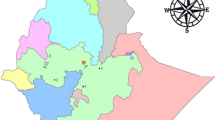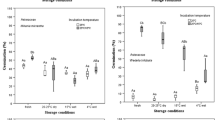Abstract
Germination ability, equilibrium relative humidity (eRH), and moisture content of ‘control’ seed samples representing 183 rice accessions stored in the active (2–4 °C) and base (−10 °C until 1993, then −20 °C) collections of the T. T. Chang Genetic Resources Center were determined after storage for 20.5–30.5 years. Germination of seeds that had been stored in the base collection was generally high (>70 %), whereas germination was more variable for seeds stored in the active collection. Samples with lower viability after storage in the active collection were likely to have lower viability after storage in the base collection. There were significant differences in the moisture content-eRH relationship of the seeds depending on whether the seeds had been stored in the active or base collection. Based on re-test data for regular seed samples regenerated in 1979–1980 and stored in the active collection for up to 31 years, estimates of the time for ability to germinate to fall to 50 % (p 50) ranged from 54 to 997 years. For the same seed samples stored in the base collection for approximately 31 years, ability to germinate has been maintained and germination increased due to improved procedures. The ability to germinate of base collection samples was also generally higher than that of ‘safety duplicate’ samples of the same seed lots that had been sent to the National Center for Genetic Resources Preservation, USA in 1981 and stored at −18 °C. This may have been due to uptake of moisture either during processing for dispatch or as a consequence of poor packaging material. The results are discussed in relation to long-term seed storage and genebank management.






Similar content being viewed by others
References
Bailly C, El-Maarouf-Bouteau H, Corbineau F (2008) From intracellular signaling networks to cell death: the dual role of oxygen species in seed physiology. C R Biol 331:806–814
Bell L, Labuza T (2000) Moisture sorption: practical aspects of isotherm measurement and use. American Association of Cereal Chemists Inc., St. Paul, Minnesota
Braunauer S, Emmett PH, Teller E (1938) Adsorption of gases in multimolecular layers. J Am Chem Soc 60:309–319
Buitink J, Walters C, Hoekstra FA, Crane J (1998) Storage behavior of Typha latifolia pollen at low water contents: interpretation on the basis of water activity and glass concepts. Phys Plant 103:145–153
Chandler RF (1982) An adventure in applied science: a history of the International Rice Research Institute. International Rice Research Institute, Los Baños
Chang TT (1991) Findings from a 28-yr seed viability experiment. Int Rice Res Newsl 16:5–6
Crisostomo S, Hay FR, Reaño R, Borremeo T (2011) Are the standard conditions for genebank drying optimal for rice seed quality? Seed Sci Technol 39:666–672
Cromarty AS, Ellis RH, Roberts EH (1982) The design of seed storage facilities for genetic conservation. International Board for Plant Genetic Resources, Rome
Eckey EW (1954) Vegetable fats and oils. Am Chem Soc Monogr Ser 123. Reinhold, New York
Ellis RH (2011) Rice seed quality development and temperature during late development and maturation. Seed Sci Res 21:95–101
Ellis RH, Hong TD (1994) Desiccation tolerance and potential longevity of developing seeds of rice (Oryza sativa L.). Ann Bot 73:501–506
Ellis RH, Hong TD (2006) Temperature sensitivity of the low-moisture-content limit to negative seed longevity-moisture content relationships in hermetic storage. Ann Bot 97:785–791
Ellis RH, Hong TD (2007a) Seed longevity: moisture content relationships in hermetic and open storage. Seed Sci Technol 35:423–431
Ellis RH, Hong TD (2007b) Quantitative response of the longevity of seed of twelve crops to temperature and moisture in hermetic storage. Seed Sci Technol 35:432–444
Ellis RH, Roberts EH (1980) Improved equations for the prediction of seed longevity. Ann Bot 45:13–30
Ellis RH, Hong TD, Roberts EH (1985) Handbooks for genebanks 2: handbook of seed technology for genebanks, vol 1, principles and methodology. International Board for Plant Genetic Resources, Rome
Ellis RH, Hong TD, Roberts EH (1988) A low-moisture-content limit to logarithmic relations between seed moisture content and longevity. Ann Bot 61:405–408
Ellis RH, Hong TD, Roberts EH (1989) A comparison of the low-moisture-content limit to the logarithmic relation between seed moisture and longevity in twelve species. Ann Bot 63:601–611
Ellis RH, Hong TD, Roberts EH (1992) The low-moisture content limit to the negative logarithmic relation between seed longevity and moisture content in three subspecies of rice. Ann Bot 69:53–58
Ellis RH, Hong TD, Jackson MT (1993) Seed production environment, time of harvest, and the potential longevity of seeds of three cultivars of rice (Oryza sativa L.). Ann Bot 72:583–590
Ellis RH, Hong TD, Roberts EH (1995) Survival and vigour of lettuce (Lactuca sativa L.) and sunflower (Helianthus annuus L.) seeds stored at low and very-low moisture contents. Ann Bot 76:521–534
FAO (2010) The second report of the state of the world’s plant genetic resources for food and agriculture. Food and Agriculture Organization of the United Nations, Rome
FAO/IPGRI (1994) Genebank standards. Food and Agriculture Organization of the United Nations/International Plant Genetic Resources Institute, Rome
Gómez-Campo C (2006) Erosion of genetic resources within seed genebanks: the role of seed containers. Seed Sci Res 16:291–294
Hanson J (1985) Practical manuals for genebanks 1: procedures for handling seeds in genebanks. International Board for Plant Genetic Resources, Rome
Hay FR, Probert RJ, Smith RD (1997) The effect of maturity on the moisture relations of seed longevity in foxglove (Digitalis purpurea L.). Seed Sci Res 7:341–349
Hay F, Adams J, Manger K, Probert R (2008) The use of non-saturated lithium chloride solutions for experimental control of seed water content. Seed Sci Technol 36:737–746
Hay FR, Smith RD, Ellis RH, Butler LH (2010) Developmental changes in the germinability, desiccation tolerance, hardseededness, and longevity of individual seeds of Trifolium ambiguum. Ann Bot 105:1035–1052
Hong TD, Linington S, Ellis RH (1996) Seed storage behaviour: a compendium. Handbooks for Genebanks: No. 4. International Plant Genetic Resources Institute, Rome
IBPGR (1976) Report of the IBPGR Working Group on Engineering, Design and Cost Aspects of Long-term Seed Storage Facilities. International Board for Plant Genetic Resources, Rome
Iguaz A, Virseda P (2007) Moisture desorption isotherms of rough rice at high temperatures. J Food Eng 79:794–802
ISTA (2005) International rules for seed testing edition 2005. International Seed Testing Association, Switzerland
Labuza TP (1980) The effect of water activity on reaction-kinetics of food deterioration. Food Technol 34:36–59
Labuza TP, Kaanane A, Chen JY (1985) Effect of temperature on the moisture sorption isotherms and water activity shift of two dehydrated foods. J Food Sci 50:385–391
Manger KR, Adams J, Probert RJ (2003) Selecting seed containers for the Millennium Seed Bank Project: a technical review and survey. In: Smith RD, Dickie JD, Linington SH, Prichard HW, Probert RJ (eds) Seed conservation: turning science into practice. Royal Botanic Gardens Kew, Richmond, pp 637–652
Mead A, Gray D (1999) Prediction of seed longevity: a modification of the shape of the Ellis and Roberts seed survival curves. Seed Sci Res 9:63–73
Miura K, Lin SY, Yano M, Nagamine T (2002) Mapping quantitative trait loci controlling seed longevity in rice (Oryza sativa L.). Theor Appl Genet 104:981–986
Nagel M, Börner A (2010) The longevity of crop seeds stored under ambient conditions. Seed Sci Res 20:1–20
Niedzielski M, Walters C, Luczak W, Hill LM, Wheeler LJ, Puchalski J (2009) Assessment of variation in seed longevity within rye, wheat and the intergeneric hybrid triticale. Seed Sci Res 19:213–224
Pérez-García F, González-Benito ME, Gómez-Campo C (2008) Germination of fourteen endemic species from the Iberian Peninsula, Canary and Balearic Islands after 32–34 years of storage at low temperature and very low water content. Seed Sci Technol 36:407–422
Pérez-García F, Gómez-Campo C, Ellis RH (2009) Successful long-term ultra dry storage of seed of 15 species of Brassicaceae in a genebank: variation in ability to germinate over 40 years and dormancy. Seed Sci Technol 37:640–649
Probert RJ, Manger KR, Adams J (2003) Non-destructive measurement of seed moisture. In: Smith RD, Dickie JD, Linington SH, Prichard HW, Probert RJ (eds) Seed conservation: turning science into practice. Royal Botanic Gardens Kew, Richmond, pp 367–388
Rahman MS, Labuza TP (2007) Water activity and food preservation. In: Rahman MS (ed) Handbook of food preservation, 2nd edn. CRC Press, Boca Raton, Florida, pp 447–476
Rao NK, Jackson MT (1996a) Seed longevity of rice cultivars and strategies for their conservation in genebanks. Ann Bot 77:251–260
Rao NK, Jackson MT (1996b) Seed production environment and storage longevity of japonica rices (Oryza sativa L.). Seed Sci Res 6:17–21
Rao NK, Jackson MT (1996c) Effect of sowing date and harvest time on longevity of rice seeds. Seed Sci Res 7:13–20
Rao NK, Hanson J, Dulloo ME, Ghosh K, Nowell D, Larinde M (2006) Manual of seed handling in genebanks. Bioversity International, Rome
Roberts EH, Ellis RH (1989) Water and seed survival. Ann Bot 63:39–52
Royal Botanic Gardens Kew (2008) Seed information database (SID). Version 7.1. http://data.kew.org/sid
Sablani SS, Bruno L, Kasapis S, Symaladevi RM (2009) Thermal transitions of rice: development of a state diagram. J Food Eng 90:110–118
Sasaki K, Fukuta Y, Sato T (2005) Mapping of quantitative trait loci controlling seed longevity of rice (Oryza sativa L.) after various periods of seed storage. Plant Breed 124:361–366
Shigemune A, Miura K, Sasahara H, Goto A, Yoshida T (2008) Role of maternal tissues in qLG-9 control of seed longevity of rice (Oryza sativa L.). Breed Sci 58:1–5
Togrul H, Arslan N (2006) Moisture sorption behaviour and thermodynamic characteristics of rice stored in a chamber under controlled humidity. Biosyst Eng 95:181–195
Vertucci CW, Roos EE (1990) Theoretical basis of protocols for seed storage. Plant Physiol 94:1019–1023
Vertucci CW, Roos EE (1993) Theoretical basis of protocols for seed storage. II. The influence of temperature on optimal moisture levels. Seed Sci Res 3:201–213
Vertucci CW, Roos EE, Crane J (1994) Theoretical basis of protocols for seed storage. III. Optimum moisture contents for pea seeds stored at different temperatures. Ann Bot 74:531–540
Walters C (1998) Understanding the mechanisms and kinetics of seed aging. Seed Sci Res 8:223–244
Walters C, Engels J (1998) Effect of storing seeds under extremely dry conditions. Seed Sci Res 8(suppl 1):3–8
Walters C, Wheeler LM, Grotenhuis JM (2005) Longevity of seeds stored in a genebank: species characteristics. Seed Sci Res 15:1–20
Xue Y, Zhang SQ, Yao QH, Peng RH, Xiong AS, Li X, Zhu WM, Zhu YY, Zha DS (2008) Identification of quantitative trait loci for seed storability in rice (Oryza sativa L.). Euphytica 164:739–744
Zeng DL, Guo LB, Xu YB, Yasukumi K, Zhu LH, Qian Q (2006) QTL analysis of seed storability in rice. Plant Breed 125:57–60
Acknowledgments
We would like to acknowledge all the staff who have worked at the T. T. Chang Genetic Resources Center since 1979 and who have therefore contributed to this data set. We are grateful to Nora Kuroda and Stephen Timple (IRRI) who assisted in the germination and moisture testing of the control samples, to Prof. Richard Ellis (University of Reading) for commenting on an earlier version of this paper, and to Dr. Robin Probert (Royal Botanic Gardens Kew) for helpful discussions. The Global Crop Diversity Trust provides financial support towards the maintenance of the rice collections in the T. T. Chang Genetic Resources Center and for safety duplication.
Author information
Authors and Affiliations
Corresponding author
Electronic supplementary material
Below is the link to the electronic supplementary material.
10722_2012_9833_MOESM2_ESM.doc
Germination re-test data for active- and base-stored samples corresponding to the 172 repatriated safety duplicates. Also shown is the latest (after 29.9–30.8 years of storage) germination result for samples from the base collection; the germination of the safety duplicates and of seeds from unopened cans, if available; and the eRH of the seeds upon opening the base-stored cans or safety duplicate packets. Note: Accession 25840 1979WS-regenerated base sample not available at the time of re-testing in 2011. (DOC 2433 kb)
Rights and permissions
About this article
Cite this article
Hay, F.R., de Guzman, F., Ellis, D. et al. Viability of Oryza sativa L. seeds stored under genebank conditions for up to 30 years. Genet Resour Crop Evol 60, 275–296 (2013). https://doi.org/10.1007/s10722-012-9833-7
Received:
Accepted:
Published:
Issue Date:
DOI: https://doi.org/10.1007/s10722-012-9833-7




